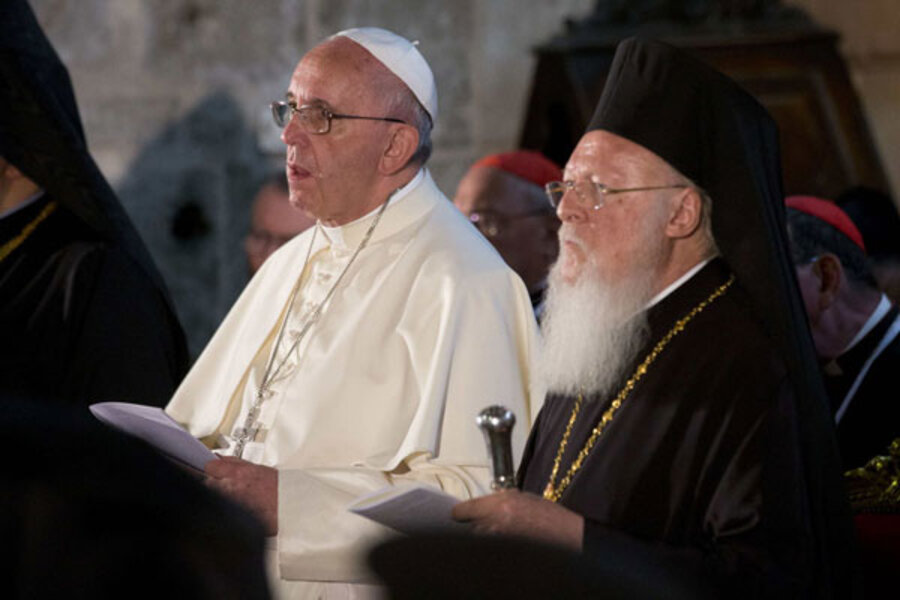Pope, Patriarch pray together in Jerusalem
Loading...
Pope Francis and the spiritual leader of the world's Orthodox Christians prayed together Sunday inside the Jerusalem church that symbolizes their divisions, calling their historic meeting a step toward healing the centuries-old Catholic-Orthodox schism.
Francis and Ecumenical Patriarch Bartholomew I embraced one another in the stone courtyard outside the 12th century Church of the Holy Sepulcher and recited the "Our Father" prayer together once inside, an unprecedented moment of solemnity at the spot where Catholic and Orthodox believe Jesus was crucified, buried and resurrected.
The encounter, punctuated by haunting Greek and Latin chants, was full of symbolic meaning: The two men, both in their mid-70s, helped one another down the stone steps leading into the church, grasping one another's forearms. And after Bartholomew delivered his remarks, Francis bent down and kissed his hand in remarkable show of papal respect for a patriarch when some 500 years ago a patriarch was forced to kiss the feet of the pope.
The evening prayer service was the spiritual highlight of Francis' three-day pilgrimage to the Holy Land and capped a momentous day in which the Israeli and Palestinian presidents accepted Francis' invitation to join him at the Vatican next month to pray for peace.
Francis has said his primary reason for coming to the region was to mark the 50th anniversary of the meeting in Jerusalem between Pope Paul VI and Ecumenical Patriarch Athenagoras of Constantinople. Their 1964 embrace ended 900 years of mutual excommunication and estrangement sparked by the Great Schism of 1054, which split Christianity.
Since that meeting, the two churches have grown closer in personal friendships and even theological dialogue, but core differences remain, including over the primacy of the pope.
Tellingly, Francis referred to Paul not as pope but as "bishop of Rome" — the other main title attributed to popes and the way Francis introduced himself to the world on the night he was elected pope in a clear gesture toward his Orthodox "brothers."
Bartholomew, for his part, called for their meeting at Christ's tomb to show how fear, religious fanaticism and hatred of people of other faiths and races can be overcome by love. "The message of the life-giving tomb is clear: love the other, the different other, the followers of other faiths and other confessions."
The site of their meeting could not have been more significant: Perhaps no other piece of real estate on Earth symbolizes the divisions of Christianity than the Holy Sepulcher, where six Christian denominations practice their faith, yet occasionally come to blows in jealously guarding their turf and times of worship.
Given the centuries of tensions underlying the visit, the seating arrangements and procession order alone were an ecclesiastical and diplomatic feat of protocol. Francis, Bartholomew and the leaders of the three main communities that share the church — Greek-Orthodox, Armenian and Roman Catholic — all sat on the same sized, gilded red velvet chairs facing the shrine encasing Jesus' tomb.
Bartholomew was the first to enter the tomb, but Francis was the first to climb the steep stairs up to the site where tradition holds Christ was crucified. The Gospel was chanted in both Latin and Greek, to appeal to the linguistic traditions of both Catholic and Orthodox. The two men recited the "Our Father" together in the relatively neutral Italian.
They embraced each other on several occasions, drawing applause from the ecumenical crowd inside the cavernous church lit by twinkling lanterns. After arriving at the church piazza from separate entrances, they left in the same car to dine together.
Though the three major denominations adamantly stick to the status quo arrangement that governs separate worship at the church, none particularly enjoys the arrangement.
"We are grown-ups. We should be able to sit down and finalize the whole thing," said the Rev. Samuel Aghoyan, the Armenian superior of the Holy Sepulcher.
"The amount of energy that's required to maintain it is counterproductive," said the Rev. Athanasius Macora, a Texas native and Franciscan monk who sits on an inter-church commission that negotiates disputes at the Holy Sepulcher.
"It's very silly. We laugh about it," said Anna Koulouris, a communications adviser with the Greek Orthodox church.







